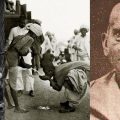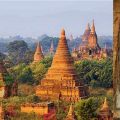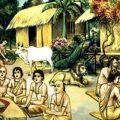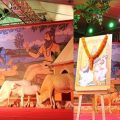Swami Shraddhananda: From Atheist to Promoter of Vedic Philosophy, Sanskrit, and Gurukul Education System
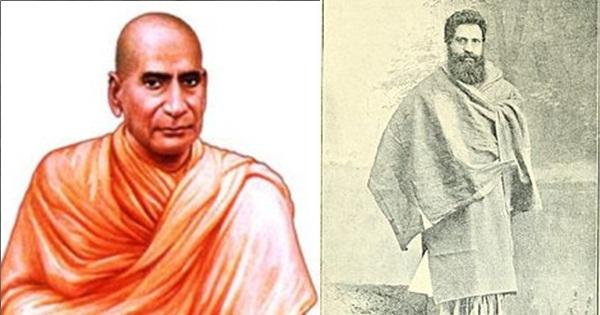
Good persons are born Good; this saying applies almost on all of the great personalities of this world. very few among the great ones are like Swami Shraddhananda whose initial days of life were in complete darkness like a sun covered by the clouds while as the clouds of ignorance shattered his life shined like a sun to set a perfect example for those who are still in darkness and wants to get inspiration from the great ones.
Swami Shraddhananda was born as Munshiram on 22 February 1856 in the village of Talwan in Jalandhar, Punjab.
Age of Darkness
Munshiram’s (Swami Shraddhananda) youth was full of ups and downs. His father Shri Nanakchand was a police inspector with constant changes in postings in Banaras, Mirzapore, Banda, Mathura and Bareilly. This disturbed the studies of Munshiram and he landed up in the company of rich friends who engaged him in cruel clenches of lust, alcohol, bhang, pan, meat eating, gambling etc. The young mind was easily influenced by his environment – “when in Rome, do as the Romans do”, was his motto. At last he passed Mukhtari exams and started his law practice to become a well known lawyer. This was a period when the son of a pious father landed up in atheism.
Munshiram used to visit a temple every night. One day the police prevented him and other devotees from entering the temple. A noble lady was doing her prayer, and nobody was allowed inside until she finished. Munshiram was terribly upset and started thinking seriously about temple and idol worship. He was assailed by grave doubts. At this stage he met a catholic priest. Under his influence he started going to church, and decided to prepare himself for baptism. This plan however came to an abrupt end. One day he went to visit The Father, but he was not in his room. Munshiram, on looking inside, saw to his horror another father in what seemed to him a compromising situation with a nun. After this his feet never turned to the church in his life.
When his father Nanakchand was posted in Benaras, a girl died at the home of a Muslim lawyer. As there was a suspicion of murder, the remains of the girl was held by the police for a post mortem examination. Another Muslim lawyer trained at Aligarh College with help of Sir Syed Ahmed Khan’s influence managed to have the investigation stopped. The case was transferred to Allahabad and his father was duly acquitted. This led to his father’s transfer to Ballia. This experience led Munshiram to turn away from Islam. Munshiram joined his father for a while in Mathura. Here he had a close experience of corrupt Hinduism. As the atheism grew in him, he was drowned in alcohol. His lot of time was wasted in friends circle, reading novels, playing chess thus neglecting his studies.
Encounter With the Revolutionary Yogi
At this grave moment the light of hopes arrived in the form of Swami Dayanand’s visit to Bareilly. His father was in charge of police arrangements for his lectures and public debate with Rev. Scott. He asked Munshiram to visit and attend his lectures. Munshiram went with his friends in order to spoil the arrangements but when he saw Rev. Scott and other eminent personalities attending his lectures he was deeply impressed. He was impressed by his strong personality and his skill in controversy. He even secretly shadowed the swami on his regular early morning walk and watched him in meditation. Perhaps he was hoping to find a chink in his armor.
He admired the fearlessness of Dayanand, who shrugged aside veiled threats. He had two private discussions with the swami on the subject of the existence of God. He confessed to the swami that he could not counter his logic, but that his arguments nevertheless had not given him real faith in God’s reality. The swami smiled and answered, “Look, you asked questions, I gave answers that were a matter of logic. When did I promise that I would make you believe in god? Your faith in God will only come when the Lord himself makes you a believer.”
Wife Shiva Devi Contribution
Munshiram mentioned in his autobiography the contribution of his wife in the period of darkness with deep respect. One evening he drank heavily with his friends and while he was vilely drunk, he found himself within the establishment of prostitutes. Somehow he got out, stumbled home and was helped by an old servant inside, where he collapsed in a drunken stupor. His young wife sat with him through that night, without food, cleaning and comforting her husband. When he finally emerged from his alcoholic daze, he realized the callousness of his behavior in contrast with the spontaneous and natural dedication of his wife.
The next day, when an enormous bill arrived from the liquor shop, Shivadevi simply offered her bridal ornaments, the most precious possession of a Hindu wife, in payment. Munshiram was shamed once more into another attempt of ordering his pitiful life.
Last Night of Darkness
Once in Jallundhar Munshiram went for drinking with his friends. On that particular night one of his friends was too paralyzed to get by himself. Munshiram somehow dragged him home. Once they had arrived, they got on the bottle again until finally Munshiram sent his companion to bed. Shortly afterwards he heard a shriek, and found his friend was about to rape a young girl of the house. Munshiram got the girl safely sway, and felt suddenly blindingly sober. He looked at himself in utter disgust, and resolutely broke the last bottle in front of him, never to touch alcohol again in his life. Almighty God was now making him a believer.
Excess of God’s Grace Overpowered Him
After completing his law studies, Munshiram started practicing as a lawyer in Jalandhar. He also joined Aryasamaj and was influenced by Lala Devraj’s personality. One of his first religious decisions was his total abjuration of meat eating. From childhood, meat had been part of his diet, as was the case with many of his friends. The decision was a sudden one, brought on by the gruesome sight of a butcher boy’s basket full of meat, after the reading of the chapter on diet in the Satyarth Prakash. That evening Munshiram stunned his dinner companions by throwing his plate of food, which included some meat, against the wall in a typical gesture of defiance and finality. In fact, he admitted that it was for lack of real courage that he had to make this gesture so dramatically. He felt he did not have the strength of character to say farewell to meat in a quiet and composed fashion.
From Atheism to Theism
Munshiram apart from practicing as a lawyer engaged slowly in the work of local Aryasamaj. He soon visited Lahore Aryasamaj and was deeply influenced by the young scientist Pt. Gurudatta’s Vedic legacy. The Aryasamaj was in its infancy and local Hindus started agitating against it. In 1886, a panchyat of learned Brahmins was called to declare Aryas of Jalandhar as outcaste. However the four prominent Brahmins involved happened to be very vulnerable as upholders of dharma. They either had a concubine, were known gamblers, or secret consumers of liquor and meat. Devraj and Munshiram visited one of them and made clear that if they participated in the panchyat, their conduct would be publicly exposed. On the day of the meeting the pundits judged it safer to stay away and the threat to samaj collapsed.
Arise of a Leader
Pundit Shyam Dass of Amritsar threw a debate on the Vedas which Munshiram accepted and handled effectively. This led him to ascend to leadership level. Munshiram started weekly Saddhrmpracharak in Urdu for propagation of Vedic philosophy. He published his first track on Varnavyastha. He started morning nagar kirtan (street preaching) and organized Aryasamaj anniversary in which Lala Saindas, Gurudatta, Lala Hansraj and two Swamis were part from Lahore delegation. The successful function put Jalandhar Aryasamaj branch on map. The main influence on Munshiram’s character was that he not only emerged as a leader but also devoted ample time to the missionary zeal of Aryasamaj apart from his practice as a lawyer. His engagements kept him away from the dark company of friends. “MY LIFE WAS NO MORE MY OWN. IT NOW BELONGED TO ALL PEOPLE” – he declared.
Pioneering Women Education
Women education was the first bold step taken by Munshiram in the field of social enlistment. Once he was reading a book at his home when he heard a song by his daughter – “Christ is your Lord Krishna, Christ is your Lord Ram”. This alerted him and made him believe that Christian missionary schools were diverting minds of youth to their sects. In 1889 he withdrew his daughter from the Christian school and decided that the Jalandhar Aryas should set up girl’s school of their own. In 1889, he started an important series of articles about female education in the second issue of Saddhrmpracharak entitled ADHURA INSAF or half justice in which he pleaded for the education of women on the basis of equal rights of males and females. His thought was influenced by the revolutionary teaching of Satyarth Prakash in which Swami Dayanand advocated female education.
Indeed Swami Dayanand was the first to roar like a lion in public platforms for female education giving evidences of women rishis like Gargi and Maitraiyi. The opposition was strong, and the going very hard; the first three attempts fell through mostly on account of the lack of pupils. The maximum resistance was by staunch Hindus who thought that it would be a real havoc if females would chant Vedic mantras. Locals protested against both of them and even tried for physical abuse many a times. Even Christian missionaries were indirectly involved as they were losing green pastures of conversion to Aryasamaj. But finally in July 1891, firm foundations were laid and the school was off to a good start.
The tribune of 16th March 1892 reported the opening of a refuse fund, and its issue of 6th July of same year reported with praise that about forty girls had been enrolled. Girls were given incentives of cloths and money to attend school. Tribune 6 Feb. 1895 reported that the school had nearly a hundred pupils in 1895. In March, a boarding house was inaugurated – the Kanya Ashram and by the end of the same year it had attracted girls not only from Punjab but also from north-west provinces and even from Poona. This showed that some people were now ready to trust the school even with the moral education and protection of their daughters. The Indian social reformer commented with high praise that it was the first such institution in India pioneering female education. In June 1896, Devraj and Munshiram finally attained their goal. They inaugurated Kanya Mahavidyalaya high school for girls. They really transformed it into major institution of female education.
(Womanhood of our country is in debt of revolutionary Sanyasi like Swami Dayanand and Swami Shraddhananda for the right to education).
Widow Remarriage Revolution
Our country was eloped in childhood marriage and natural epidemics after Islamic invasion and ruler. This led to rising of brigades of child widows who had never even seen the faces of their grooms. SWAMI DAYANAND in SATYARTH PRAKASH first advocated remarriage of widow. Following his message people started widow remarriage but so called staunch Hindus opposed this move. They were ready to keep an innocent girl for whole life either at their home or in Benaras, Mathura to land up in prostitution or sexual exploitation but not ready for their remarriage.
Aryasamaj started widow remarriage with missionary zeal. In 1895 one Diwan Sant Ramdas arranged the remarriage of his daughter, who had been married in early childhood, but had been widowed long before that marriage could be consummated. Many orthodox Hindus argued that this remarriage of a widow was against Hindu dharma. The Chopra community of Akalgarh published a treatise pressing for the total excommunication of the Diwan. Munshiram undertook his defense. He published a pamphlet entitled Kshatra Dharma palan ka gair mamuli mauka (an unusual opportunity to defend the Dharma of the Khatris). He supported widow remarriage and supported his claim by texts from Vedas and Manu Smriti. The pamphlet closed with a passionate appeal to all Hindus to do all they could to accept remarriage of widows in all cases where the Hindu religion allowed it.
Munshiram struggled all his life for the upliftment of widows. At last in 1925, he got success in his mission. At a regional widow remarriage conference held in his own town of Jalandhar, addressing as chairman of conference, he passed resolution of disapproval of marriage of boys before they were twenty- five years old and of girls before the age of sixteen. Such unions were in violation of the Shastras. It was also stated that no widower should marry a virgin, nor should a widow marry a bachelor, and that the marriage of virgin widows should be celebrated in exactly the same manner as that of virgin brides. Moreover, children born from the union of widow and widowers should enjoy the same legal rights and privileges as those born in the first marriage. These were indeed revolutionary resolutions, worthy of the radicalism of Swami Dayanand himself.
New Dream of Gurukula
Munshiram felt many a time that the education pattern of the D.A.V. schools will not produce a truly national adult, who was prepared to structure his life according to that Vedic ideal, and devote his formative years to its study. The main thrust of the instruction was therefore to be the study of the Vedas and of all the linguistic and historical disciplines necessary for that study. The Gurukul syllabus included Sanskrit as its main curriculum supported with subjects like English, science, math and history.
Munshiram first opened its small branch in May 1900 in Gujranwala but was not satisfied by its location. He was donated land for Gurukul by Munsi Amar Singh near village Kankhal; Haridwar. Finally on 2nd March, 1901, Munshiram opened his dream Gurukul. It was first two bighas of open space in the midst of thick jungle, two rows of thatched huts, a small cabin, and cattle shed. That was the beginning. Fifteen years later on 12th April 917 when Munshiram entered Sanyas, the Gurukul was a large complex of brick buildings housing a school with 276 pupils, university section with sixty four students, and staff of thirty five teachers. There were ample classrooms, dormitories, a library, science laboratories, a hospital, workshops, an agricultural institute, a guest house, etc.
Other Gurukul branches were also opened in Multan, Kurukshetra, Indraprastha, and Rohtak. It was later followed by hundreds of Gurukuls all over country both for boys and girls. Gurukul system of education was a revolutionary step in field of education. It was education based on Vedic knowledge with ancient pride of our country filled in the veins of all students. Gurukul did not accept any government grant. It was self dependent in its every aspect in British ruled India. C.F. Andrews was so influenced by the Gurukul atmosphere that he wrote about his impressions in the modern review of March as “here was the India that I has known and loved – the India of my dreams only in decay, but ever fresh and young with the spring time of immortal youth…here in the gurukul was the new India.” (Ref- Gispert-sauch, ed., God’s word among men, Delhi, 1973, p. 75).
Savior of Aryasamaj and the Gurukula
Arrest and deportation of Lala Lajpat Rai fell like a bombshell among Aryas. Britishers assumed activities of Aryasamaj as a plot to overthrow the government. Munshiram immediately took up defense of Aryasamaj. He produced constant stream of articles from the Punjabee newspaper of 12 June 1907 to large works like the Aryasamaj and politics, a vindication in 1910. He proved that Aryasamaj was a purely religious body, not a political one, and that it had no connections with any political grouping. He said that Dayanand’s writings had no reference to politics. He said he had no sympathy whatsoever with any political group or action which the government may have considered seditious. But at the same time Munshiram publicized the way the British government and British army officers were unjustly harassing the Aryas. He even mentioned such list of harassment of Aryas in his book the vindication. On 23 August 1907, he suggested that Lord Minto should send for some leaders of the samaj and talk freely with them. He advocated that Aryasamaj should not send a deputation like beggars to Britishers.
When Munshiram was called by Sir John Hewitt he asked him to issue a proclamation declaring that no person shall be declared disloyal simply because he is an Aryasamajist. He appealed to Lord Minto not to give credence to malicious informants. He even defended Lajpat Rai in the Punjabee of 12th June 1907 “we believe that these gentlemen were advocates of constitutional agitation only, and that sedition had no place in their minds”. When the others remained silent, he repeated that fearless expression of his opinion of Lajpat Rai in civil and military gazette of June 1907 and in his Lahore speech of Nov. 1908. (Vindication p-78). Even Gurukul Kangri was considered as centre of sedition. Munshiram invited British officials to the Gurukul.
In 1913 Sir James Meston, Governor of U.P. and C.F.Andrews visited the Gurukul and praised it as real India. Friendship sprang between him and Munshiram. C.F. Andrews was close to Viceroy Lord Harding. His relations helped to create good atmosphere between Gurukul and the government. Other eminent personalities to visit Gurukul were Ramsay MacDonald and finally Viceroy Lord Chelmsford in Oct. 1916.
Transformation of Munshiram into Swami Shraddhananda
On 12th April 1917, Munshiram took sanyas in the presence of 20,000 witnesses. The ancient ceremony symbolized the final severance of the bonds of the old life. He performed his own funeral rites and shed the garments characteristic of Mahatma Munshiram. The outward indication of the entrance into new state of life was the shaving of head and beard, the assumption of the ochre robe, and the acceptance of a new name. Munshiram expressed himself in his biography (p-451-452) on sanyas “it is faith (shraddha) that was the inspiration of the life I have led so far. Faith has always been the revered goddess of my life. Today also it is faith that has driven me to enter the state of sanyas. That is why, invoking as witness this sacrificial fire, I name Shraddhananda, so that I may succeed in filling my future life too with that same faith”
Normally the candidate named another sanyasi as his guru, who then conducted part of the ceremony. Munshiram declared god to be his guru, and performed all rites himself. He cut of all his ties with family, professional career, power structure of Aryasamaj, and personal property. As sanyasi he was a totally free individual not answerable to any demands of the social or ritual power structures of Hinduism.
Thereafter Swami Shraddhananda took part in politics and worked a lot for removal of untouchability. Initially he supported Mahatma Gandhi but later had major differences.
The Martyrdom
In March 1926 Swami Shraddhananda performed a Suddhi in Delhi that shook the Muslim community. A Muslim lady from Karachi, Asghari Begum, arrived in the capital and asked Swami Ji to be converted to Aryan faith. She had read a lot about Hinduism, and had decided to undergo Suddhi and become a member of the Aryasamaj. Against will of her husband she had secretly left her home and made her way to Delhi with her children. The ceremony was duly performed; she was given the new name Shanty Devi, and with her children was put up in the Arya widow’s home. Months later her husband tracked her down in Delhi, and he attempted to persuade his wife to change her mind. When this proved unsuccessful, he instituted on 2nd Sept. a law case against Swami ji, Shanty Devi, Swami Ji’s son Indra and Swami Ji’s son in law Dr Sukhdeo, for conspiracy in the abduction of his wife and children. The case was finally decided by the court on 4th December with clear acquittal of all the accused (leader 2 oct. 1926).
During these months Muslim community was in a ferment of indignant animosity over the incident. Some Muslim papers were violent in their condemnation of Swami Shraddhananda, especially Hasan Nizami in his Darwesh. For months Indra was extremely concerned about the safety of his father, who stubbornly insisted on ignoring all threats and continued to take evening walks in the surrounding Muslim quarter. (PITA p-291)
In December from his trip to Benaras Swami Shraddhananda fell very ill. He was diagnosed as bronchial pneumonia patient by Dr Sukhdeo and Dr Ansari. Swami Ji realized that death had hovered close. He said “this body is no longer capable of service. My wish is that I be reborn in India so that I can serve her again” (PITA p-638)
On 23rd Dec. Indra and others had paid their usual visit to Swami ji around midday, and they left him to have some rest. Around 4 p.m. a Muslim called Abdul Rashid came to the house and asked to see the Swami in order to discuss some problems of Islamic religion. Dharma Singh, Swami Ji’s personal attendant was inclined to refuse him access, but the visitor insisted. When the Swami called his attendant, and was told of the visitor, he invited him in and explained that he could not help him right away, but would be happy to do so later. The visitor then asked for a glass of water, and while Dharma Singh was taking his glass away, he rushed up to Swami Shraddhananda and fired two bullets point-black into his chest. Dharma Singh came running and was shot in the thigh. The commotion brought Dharmpal, the swami’s secretary running. He overpowered the assassin and held him till the police arrived. (PITA p.283) Indra arrived within minutes, but the Swami had died instantly. As he looked upon his father’s face, peaceful in death, Indra thought of these words the swami had uttered not long before. “Yet it is a source of contentment to me that I am singled out as the one worthy of wearing the crown of martyrdom” (BIO –p.598).
25th Dec, 1926 witnessed the last journey of the great swami whose whole life was dedicated for the Vedic dharma. The crowd was uncontrollable through the streets of Delhi and his last rites were performed by Indra.

